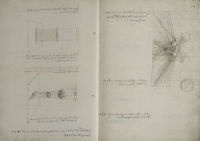Light and Vision Click on the thumbnails to explore the trail
Read more about this trail (expand)
According to Leonardo, the most important of the five senses was sight, the eye being the “window of the soul”. Leonardo thought a great deal about how the eye functioned and how we experience the world in terms of light and shade. His studies of the effects of light on form provided the basis for a revolution in the way that light, colour and space were described in painting.

- Enlarge
- Zoom & explore
- Fol 18v-19r - Studies of light and shade. Photo RMN - © René-Gabriel Ojéda
Paris Manuscript C 1490-91
Leonardo’s understanding of light became increasingly sophisticated as he developed an increasingly scientific approach to the subject. One of his main objectives was the grading of light and shade according to the quantity of illumination and angle of exposure. This he saw as a rigorously proportional effect and therefore proof of the universal rules underlying the behaviour of all the powers of nature.
On Manuscript C Fol19r two spherical light sources illuminating two opaque bodies are enclosed within a rectangular frame. Multiple lines indicate the luminous and shading rays of the bodies. The resulting pattern indicates regions of shadows of varying density. Leonardo’s notes focus on the action of shadow on shadow. The more different the intensities of darkness between two rays of “imperfect shadowiness” the more different the shadows resulting from their mixture. Also, it is impossible for the mixture of two shadows to result in a shadow of darker quality.
Sheets such as this demonstrate the astonishing complexity of Leonardo’s investigations. Ultimately they led to an understanding of light and shade that far surpassed that of any scientist or artist of his time.
In Leonardo's words
Shadows and lights are the most certain means by which the shape of any body becomes known, because a colour of equal lightness or darkness will not display any relief, but gives the effect of a flat surface, which with all its parts at equal distance will seem equally distant from the brightness that illuminates it.
Paris Manuscript C is primarily a neatly laid out treatise on light and shade. Other topics are also considered, with early observations on the flow of water and percussion. These were more systematically studied by Leonardo in later manuscripts.
The manuscript comprises of 28 folios, with one section missing.
- Medium Pen and ink on paper
- Size 30.7 x 22 cm
- Location Bibliothèque de l’Institut de France










